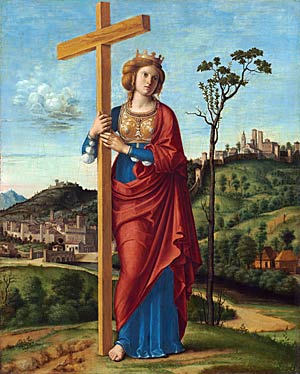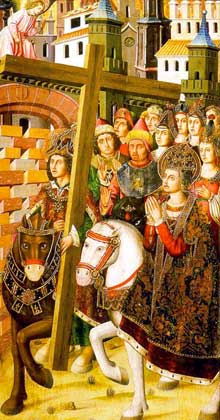Readings:
PRAYER (traditional language)Micah 4:1–4
Psalm 2
1 Corinthians 3:8-15
Luke 23:26–32Preface of Holy Week
Most Merciful God, who didst vouchsafe to bless thy servant Helena with such grace and devotion to thee that she didst venerate the very footsteps of our Savior; Grant unto us the same grace that, aided by her prayers and example, we too may evermore behold thy glory in the cross of thy Son. Through the same Jesus Christ our Lord; who liveth and reigneth with thee, in the unity of the Holy Ghost, one God, for ever and ever. Amen.
PRAYER (contemporary language)
Most Merciful God, who blessed your servant Helena with such grace and devotion to you that she venerated the very footsteps of our Savior; Grant unto us the same grace that, aided by her prayers and example, we also may always behold your glory in the cross of your Son. Through the same Jesus Christ our Lord; who lives and reigns with you, in the unity of the Holy Spirit, one God, for ever and ever. Amen.
Lessons revised in Lesser Feasts & Fasts 2024.
Return to Lectionary Home Page
Webmaster: Charles Wohlers
Last updated: 22 March 2025
HELENA OF CONSTANTINOPLE
PROTECTOR OF THE HOLY PLACES, 330
 Helena, or Saint Helena (Greek: 'Aγία 'Eλένη, Hagía Helénē, Latin: Flavia Iulia Helena Augusta; c.246/248 – c. 330), was an Empress of the Roman Empire, and mother of Emperor Constantine the Great. Born the lowest of commoners, possibly in Drepana, Bithynia in Asia Minor, she became the consort of the future Roman Emperor Constantius Chlorus (reigned 293–306) and the mother of the future Emperor Constantine the Great (reigned 306–337).
Helena, or Saint Helena (Greek: 'Aγία 'Eλένη, Hagía Helénē, Latin: Flavia Iulia Helena Augusta; c.246/248 – c. 330), was an Empress of the Roman Empire, and mother of Emperor Constantine the Great. Born the lowest of commoners, possibly in Drepana, Bithynia in Asia Minor, she became the consort of the future Roman Emperor Constantius Chlorus (reigned 293–306) and the mother of the future Emperor Constantine the Great (reigned 306–337).
Helena ranks as an important figure in the history of Christianity and of the world due to her influence on her son. In her final years, she made a religious tour of Syria Palaestina and Jerusalem, during which she allegedly discovered the True Cross.
Helena gave birth to the future emperor Constantine I on 27 February, probably around 272. In order to obtain a wife more consonant with his rising status, Constantius divorced Helena some time before 289. Helena and her son were dispatched to the court of Diocletian at Nicomedia, where Constantine grew to be a member of the inner circle. Helena never remarried and lived for a time in obscurity, though close to her only son, who had a deep regard and affection for her.
Constantine was proclaimed Augustus of the Roman Empire in 306 by Constantius' troops after the latter had died, and following his elevation his mother was brought back to the public life in 312, returning to the imperial court. She received the title of Augusta in 325. According to Eusebius, her conversion to Christianity followed her son becoming emperor.
In 326-28 Helena undertook a trip to the Holy Places in Palestine. According to Eusebius of Caesarea, who records the details of her pilgrimage to Palestine and other eastern provinces, she was responsible for the construction or beautification of two churches, the Church of the Nativity, Bethlehem, and the Church of Eleona on the Mount of Olives, sites of Christ's birth and ascension, respectively.
 At the time of Helena's pilgrimage, Jerusalem was still being rebuilt following the destruction caused by Titus in AD 70. Emperor Hadrian had built during the 130s a temple over the site of Jesus's tomb near Calvary, and renamed the city Aelia Capitolina. According to Eusebius, "[t]here was a temple of Venus on the spot. This the queen (Helena) had destroyed."According to tradition, Helena ordered the temple torn down and, according to the legend that arose at the end of the 4th century, chose a site to begin excavating, which led to the recovery of three different crosses. Helena had a woman who was near death brought from the city. When the woman touched the first and second crosses, her condition did not change, but when she touched the third and final cross she suddenly recovered, and Helena declared the cross with which the woman had been touched to be the True Cross. On the site of discovery, Constantine ordered the building of the Church of the Holy Sepulchre.
At the time of Helena's pilgrimage, Jerusalem was still being rebuilt following the destruction caused by Titus in AD 70. Emperor Hadrian had built during the 130s a temple over the site of Jesus's tomb near Calvary, and renamed the city Aelia Capitolina. According to Eusebius, "[t]here was a temple of Venus on the spot. This the queen (Helena) had destroyed."According to tradition, Helena ordered the temple torn down and, according to the legend that arose at the end of the 4th century, chose a site to begin excavating, which led to the recovery of three different crosses. Helena had a woman who was near death brought from the city. When the woman touched the first and second crosses, her condition did not change, but when she touched the third and final cross she suddenly recovered, and Helena declared the cross with which the woman had been touched to be the True Cross. On the site of discovery, Constantine ordered the building of the Church of the Holy Sepulchre.
Helena died around 330, with her son at her side. She was buried in the Mausoleum of Helena, outside Rome on the Via Labicana.